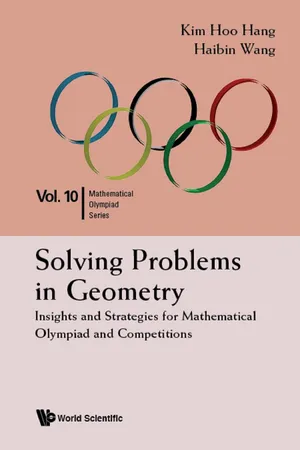Mathematics
Using Similar Polygons
Using similar polygons involves identifying and working with shapes that have the same shape but different sizes. When two polygons are similar, their corresponding angles are equal, and their corresponding sides are in proportion. This concept is useful in various mathematical applications, such as solving for unknown side lengths or finding the scale factor between two shapes.
Written by Perlego with AI-assistance
Related key terms
3 Key excerpts on "Using Similar Polygons"
- eBook - ePub
- Edward T Walsh(Author)
- 2014(Publication Date)
- Dover Publications(Publisher)
Geometry will draw the soul toward truth.PLATOCHAPTER SIX
SIMILARITY
6.1 INTRODUCTION
In the sixth century B.C ., the illustrious mathematician Pythagoras founded a school which adopted the philosophical premise that the examination of everything in nature, geometric forms included, would yield properties that could be expressed in terms of whole numbers. According to legend, the Pythagoreans were onboard ship when one of them demonstrated to the others that, no matter what unit of measure was employed, it was impossible to express the lengths of the legs and hypotenuse of an isosceles right triangle as whole numbers. Since this fact violated Pythagorean doctrine, it was viewed as a serious threat by the Pythagoreans, who responded by throwing its heretical author overboard–or so the story goes.Thus was generated a “crisis” in mathematics which lasted for nearly two hundred years, until Eudoxus invented his elegant and ingenious theory of ratio and proportion. Eudoxus’ work is generally believed to have furnished the entire content of Book V of Euclid’s Elements.In previous chapters, we examined the congruence relation between geometric sets of points. Specifically, we defined congruence for segments, angles, and triangles. When we say that two such figures are congruent, we are saying that they are the same shape and the same size.In this chapter we will begin to consider relations between figures that are the same shape but not necessarily the same size. We have a name for such figures: We say they are similar.Eudoxus’ theory of proportion provides the tools we will use to explore and refine the similarity relation. The notion of similarity will then lead us to a proof of what is known as the Pythagorean Theorem - eBook - ePub
Talking about God
The Concept of Analogy and the Problem of Religious Language
- Roger M. White(Author)
- 2021(Publication Date)
- Routledge(Publisher)
The starting point for explaining the particular kind of model that can be defined using analogy is Euclid Book VI. It is here that we find the raw materials for defining the simplest of all such models—the scale model.Euclid VI, Definition 1: Similar rectilinear figures are those which have their several angles equal, each to each, and the sides about the equal angles proportionals.Book VI is principally concerned with the properties of similar figures, of which the simplest examples are similar triangles. As said in this first definition, it is the idea of proportionality, or analogy, that explains the relevant notion of similarity. Suppose we have two triangles, ABC and A’B’C’, such that pairs of corresponding sides are analogous to one another (AB/A’B’ = BC/B’C’ = AC/A’C’), then the triangles are called similar.17 This in fact gives us the simplest kind of scale model: one triangle may in this case be considered as a scale model of the other.The idea of one triangle being similar to another can readily be extended to the case of an arbitrary rectilinear figure being similar to another, and in Proposition 18 of Book VI Euclid gives the simple construction necessary if you wish to construct a rectilinear figure that is a model of a given one: you only need to ensure that every triangle in the original figure is similar to the corresponding triangle in the model. This suffices to give us the general notion of a scale model: a scale model of a given figure (rectilinear or otherwise) is a second figure in which every triangle inscribed in the model is similar to the corresponding triangle in the original figure.Although if we wish to understand the notion of an analogical model in general we shall need to consider far more complex and subtle cases than the simple case of the scale model,18 it is worth pausing to consider this case, since we arrive at the general notion by extending ideas that are already present in the idea of the scale model. One of the main concerns of Book VI is to decide which geometrical properties will be held in common by the two similar figures: thus, to give simple examples, we can prove that corresponding angles will be equal,19 - eBook - ePub
Solving Problems in Geometry
Insights and Strategies for Mathematical Olympiad and Competitions
- Kim Hoo Hang, Haibin Wang;;;(Authors)
- 2017(Publication Date)
- WSPC(Publisher)
Chapter 2Similar TrianglesSimilar triangles are the natural extension of the study on congruent triangles. While congruent triangles describe a pair of triangles with identical shape and size (area), similar triangles focus on the shape. The diagram below gives an illustration.Indeed, similar triangles are even more powerful tools than congruent triangles. Many interesting properties and important theorems in geometry could be proved by similar triangles.One would see in this chapter that the Intercept Theorem plays a fundamental role in studying similar triangles, while the proof of this theorem is based on an even more fundamental concept: area. 2.1 Area of a TriangleIt is widely known that the area of ΔABC, denoted by [ΔABC] or SΔABC, is given by where h denotes the height on BC.Of course, one may replace BC and h by any side of the triangle and the corresponding height on that side.Notice that implies that if two triangles have equal bases and heights, they must have the same area. Even though this is a simple conclusion, it has a number of (important) variations:• In a trapezium ABCD where AD // BC and AC,BD intersect at E, we have [ΔABC] = [ΔDBC] because both triangles have a common base and equal heights.By substracting [ΔBCE] on both sides of the equation, we have [ΔABE]=[ΔCDE]. Refer to the diagram above.• In a triangle ΔABC where M is the midpoint of BC, we must have [ΔABM]=[ΔACM]. Let D be any point on AM. We also have [ΔBDM]=[ΔCDM]. Refer to the diagram below.It follows that [ΔABD]=[ΔACD]. Since ΔABD and ΔACD have a common base AD, we conclude that the perpendicular distance from B,C respectively to the line AM is the same.Notice that the conclusion above still holds even if D is a point on AM extended. Refer to the diagram below.If M is the midpoint of BC, can you see [ΔABD]=[ΔACD]?• Refer to the diagram below. Given a triangle ΔABC, extend BC to D such that BC = CD. E is a point on AC. Draw a parallelogram CDFE. Connect BE, BF and AF. One sees that the area of the shaded region is equal to the area of ΔABC
Index pages curate the most relevant extracts from our library of academic textbooks. They’ve been created using an in-house natural language model (NLM), each adding context and meaning to key research topics.


